With its towers and spires peaking out from over the walls, Tallinn’s Old Town is not only a tourist trap or a UNESCO World Heritage Site but also a bustling mini-city inside of a large stone wall, parts of which are still intact for over 600 years. Probably the majority of tourists coming through Tallinn are there solely for the Old City but actually it contains the President’s House, the Parliament, Estonian Parliament, and a lot of houses and businesses for the locals as well.
One thing that has really stood out for me in Tallinn has been the architecture. I haven’t had a chance to go to the museum of architecture yet but even just walking up and down the streets in the city has been an education by itself. Estonia was occupied or owned by other countries for most of its history but has never been a large population or had a strong army so many times the conquering seemed (on the surface) peaceful. Unlike most of the countries involved in the World Wars, Estonia never received heavy shelling, bombing, or habitual destruction from neighbors so most of its buildings remain from bygone eras including the Old Town whose helpful plaques remind you that some buildings here are from the 1200s and 1300s.
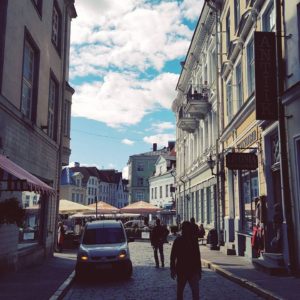

A view in to the plats, one of many small churches in Old Town
Estonia was a port city and its ownership by Danes, Germans, Russians, and close ties with its Baltic neighbors and Finland mean that the architecture is often a mismosh of these with some influences in style from other sources. Buildings in the Old Town are often medieval looking buildings directly next to 1700s style German cottages or 19th century Russian spires.
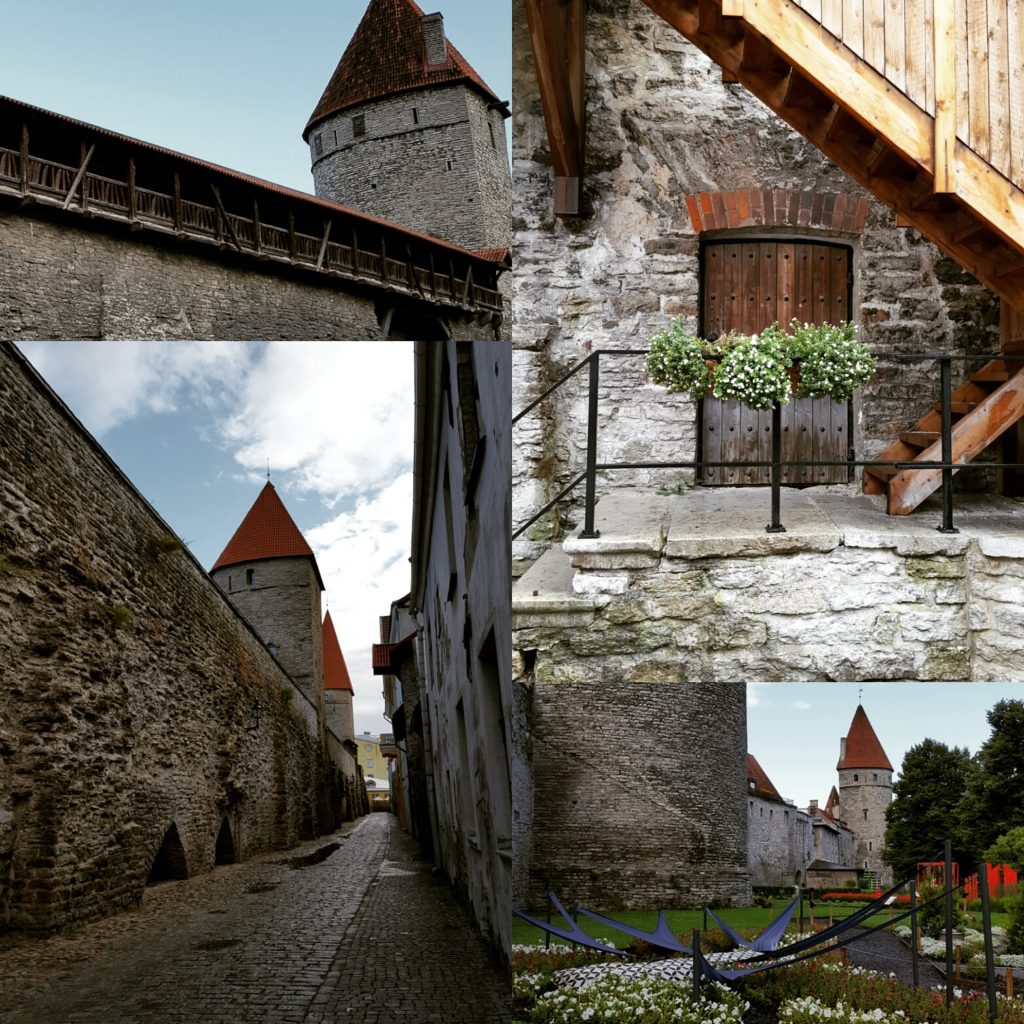 Multi views of the Nunna, Sauna and Kuldjala Towers
Multi views of the Nunna, Sauna and Kuldjala Towers
The Old Town has been refurbished when needed but many of the structures and wall are the same as when they were constructed, even going so far as some of the towers have cannonball holes in the side from when they were attacked. The castle structure above has an entire set of wall and a full maintained garden in front. You can walk the stairs up to the sunken inset and below the grates for drainage run in cobblestone (which means they flood a lot even when the rain is light). You can see the addition of modern style stairs but mostly thing have been left alone as much as possible.

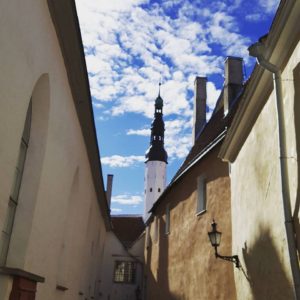
The door separating upper and lower Old Town, spire of a church through an alleyway
There are two parts of Old Town: Upper and Lower and in this picture on the left, a door separates them. One of Andrew’s coworkers told us that Estonians have a long history of unrest with their rulers and that this door separated the upper class (in the upper city) and lower class (literally in a lower city) and was heavy enough so that it could not be broken through in times on unrest.
The stairs wind that divide the classes are winding but when you reach the top, the city up top is actually not too much different than the lower city. The lower city has smaller, clumped together houses and much more textured walls but the upper city only has a handful of larger buildings (most of them now serve of consulates), though the churches there are not as impressive looking as St. Olaf’s or St.Nicolas’.
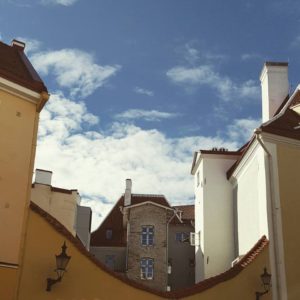
 Modern and old style blending, me wearing a tower for a hat.
Modern and old style blending, me wearing a tower for a hat.
Some of the buildings had a more modern fusion to them with later style lamps, outdoor lighting, different styles of sidewalk laid, modern stone statues, or the outside of buildings sheered smooth, the whole effect though is that when you step in to Old Town you feel as though you have just flipped a switch and gone back in time. The roads, while they do hold cars and taxis now, are all a mix on concrete and cobblestone – uneven and harsh on tires and horses and feet alike. While buildings may have been reinforced and there was plenty of renovation based construction going on while we were there, it really is a magical storybook style place. It’s worth the visit and dotted with 100s of places to duck in and get coffee, food, local color, antiques, and even cigars and whiskey!
 The View from Toompea, the Upper Town
The View from Toompea, the Upper Town
The funniest thing is that Old Town is also just a regular place in Tallinn. There are language schools, dry cleaners, supermarkets, and the Parliament all scattered at the edges that function for people who live here year round. You can buy or rent apartments in the Old Town and we saw many people sitting on their balconies just enjoying a cup of coffee and watching tourists flock to the markets and concerts that fill the squares up during the weekend.
Unlike Williamsburg, Virginia in the US, the Old Town is not a play place where time has been frozen as a teaching exercise. There are only a handful of people in costume, mostly leading tours or trying to make a buck but only in the way that the Pike Place Market is for tourists in Seattle. It’s a place that exists to the mutual benefit of the town (bringing in tourism is good for everyone) but also exists because there is space in Tallinn and in Estonia for remembering and embracing the past.
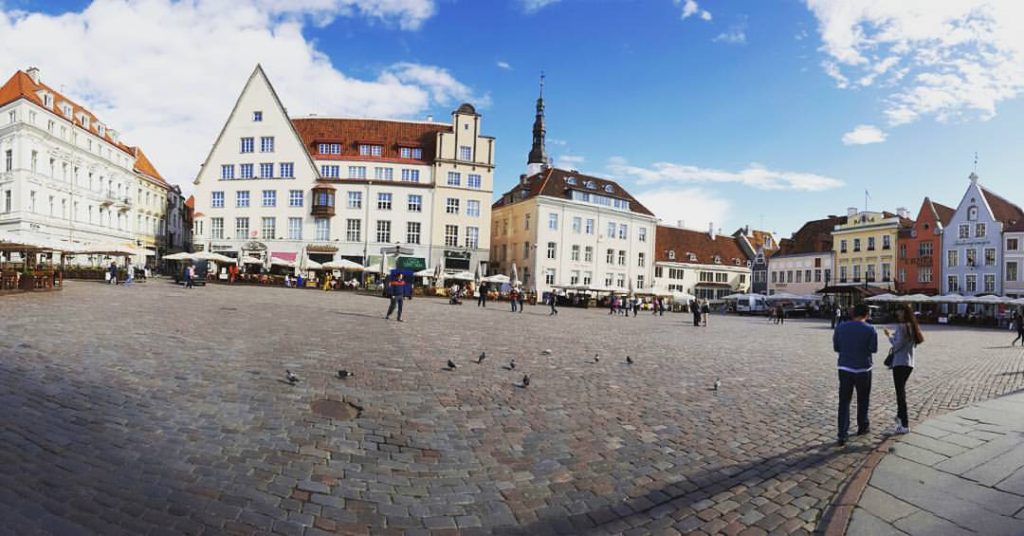 Raekoja plats, Town Hall Square
Raekoja plats, Town Hall Square
The Old Town connects Estonia to a different time and inside of it there is a small walkway with stones all lined up with dates on it. You can walk the path alongside Estonia’s most memorable moments as stones at your feet. That’s what it feels like to be in the center of the town square that looks the way it did in the 1600s. In any other city it might stand as a sharp contrast to the modern metropolis outside but in Tallinn, outside the Old Town’s wall there is some leakage of history in the buildings. I hope to be able to take pictures of more of them but buildings in the main city range from the 1700s to today and in that way, Old Town feels more integrated than its high walls would have you believe.
Head aega!
